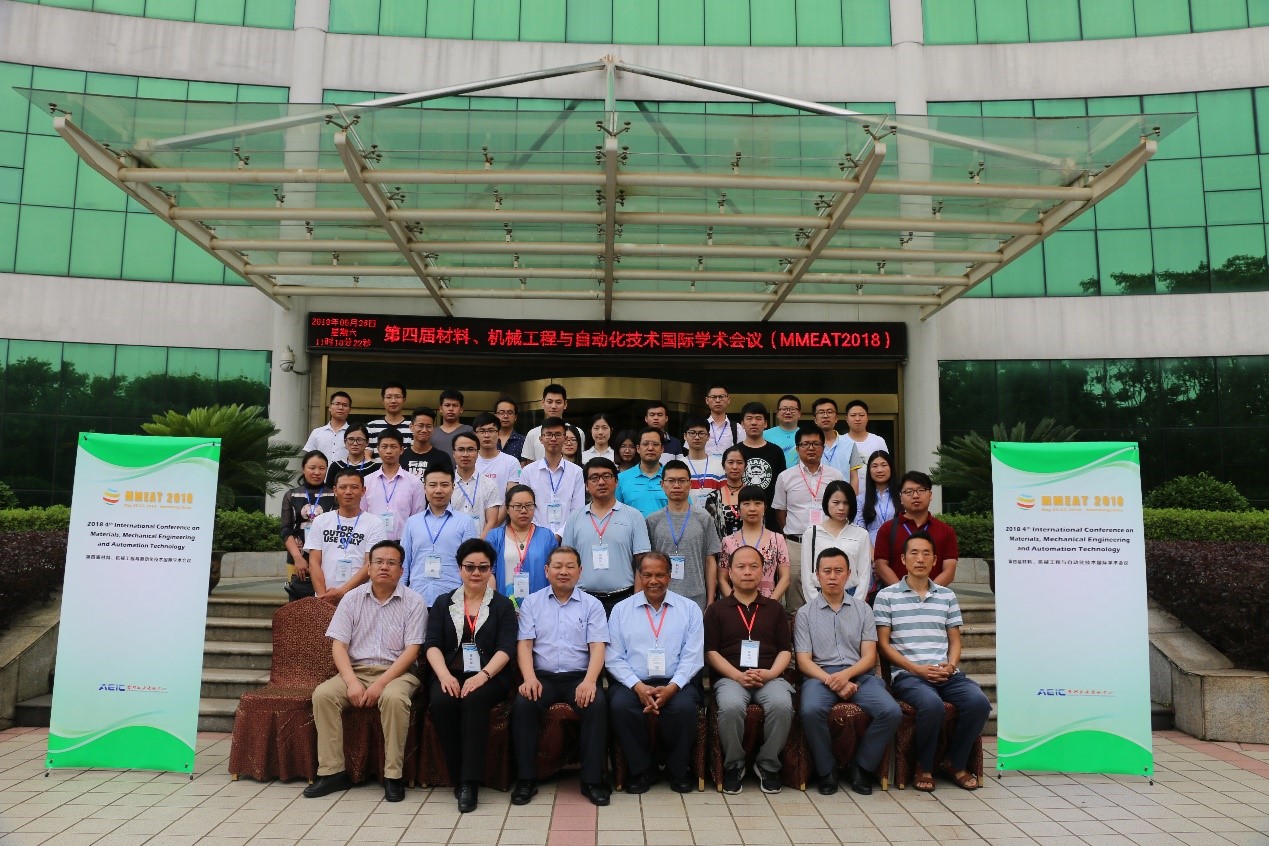MMEAT2018 was successfully taken place on Mar 15-17, 2017 in Nanchang, China!【Photo】
日期:11/09/2018 点击量: 707次
Keynote Speakers

Dr.Mahendra Mallick, Independent Consultant, USA
Title: Histrory, Development, and Applications of Estimation Theory and Linear and Nonlinear Filtering
Abstract: Estimation and filtering algorithms are widely used in space applications, sonar, radar, video and tracking, robotics, computer vision, biomedical applications, air traffic control, autonomous driving systems, etc. In this talk we shall discuss the history of estimation theory starting with Gauss’s formulation of least-squares (LS) applicable to the motion of planets, comets, and asteroids. The differences between the Fisher formulation and Bayesian formulation in estimation theory will be analyzed. Special attention will be given to the famous Kalman filter (KF), which forms the foundation of many current nonlinear approximate filters such as the extended KF (EKF), unscented KF (UKF), and cubature KF (CKF). Furthermore, the talk will discuss controversies associated with the invention of the LS and KF. We shall also cover the sequential Monte Carlo based particle filter (PF), which has received a great deal of attention during the last two decades because of its ability to handle nonlinear non-Gaussian filtering problems. We shall summarize various nonlinear filters and present numerical results for some real-world filtering problems.

Prof.Jie Du, Hainan University, China
Title: DNA Nanotechnology Assisted by
Cationic Comb-type Copolymer
Abstract: Nanometer-scaled
DNA devices based on programmed assembly of DNA helices has become a powerful
tool in DNA nanotechnology fields beyond its biological
importance. Numerous endeavors have been reported on the use of
light irradiation, changes in environmental pH or
ion, and the addition of DNA oligonucleotides or enzymes asexternal
stimuli for DNA nanomachines.For most of the DNA nanomachines constructed so
far, oligonucleotides have been generally used as fuel. The
common operating principles employed in this DNA-fueled
nanomachine involve sequence-specific hybridizations and strand
exchange reactions between the machine body and the
sequential addition of DNA fuels. However, the operating conditions of
the DNA-fueled nanomachines are limited. For example, the
switch frequency is limited by the hybridization kinetics of complementary
strands; it needs a high concentration of DNA oligonucleotide to retain the
machine’s dynamicaction; a
DNA duplex waste is produced in each cycle, and accumulation of the
waste products leads to a progressive loss of
operating efficiency. To overcome these weaknesses, a new strategy
is therefore required for the development of DNA nanotechnology.Our group
developed a cationic copolymer-assisted strategy to solve this problem.
This strategy is partially an extended work of our previous studies on
interactions between cationic comb-type copolymers (CCCs) and triplex or
duplex DNA. In those studies, we demonstrated that CCCs composed of a
polycation backbone and abundant hydrophilic graft chains (>90 wt%)
influence the kinetics and thermodynamics of nucleic acid hybridization under
physiologically relevant conditions. Detailedly, we found that the
poly-(L-lysine)-graft-dextran (PLL-g-Dex) copolymer
significantly accelerates DNA hybridization. Moreover, the
copolymer markedly accelerates the strand-exchange reaction (SER)
and increases the stability of dsDNA relative to that in
buffer alone. The SER acceleration of the copolymer has
been applied for refining the DNA detection method and
DNA nanodevices with improved response even at 200 times lower strand
concentration (nanomole per liter range) than those in other
reports. The foundation of our research is the interaction mechanism of
CCCs and nucleic acid. The CCCs reduce an entropically unfavourable
counterion condensation effect that accompanies a nucleation process of SER,
lowering the energy barrier associated with breakage and reassociation
of the nucleic acid base pairs.

A.Prof.Yulin Mei, Dalian University of Technology, China, China
Title: Research on Acoustic Metamaterials with Unit Cell of Micro-trusses
Abstract: As a new type of acoustic metamaterial, the pentamode material has extensive application prospect in controlling acoustic wave propagation because of its fluid properties. On the one hand, a kind of pentamode material unit cell is designed, which is a two-dimensional honeycomb truss structure, and then an acoustic cloak with isotropic density and gradient elastic modulus is constructed by periodically assembling the unit cell. Where, the influence of the geometric parameters and material composition of the unit cell on its mechanical properties is studied and the stealth effect of the acoustic cloak is proved. On the other hand, an optimization method for the design of PM metamaterial structure with unit cell of micro trusses is presented. With incorporating the transformation acoustics algorithm into the optimization process to predict the theoretic material parameters of the current design structure, the design of PM material structures can be realized as a problem of structure size optimization, and the optimized result can meet the requirement of PM metamaterial property and the theory of transformation acoustics. And also, the total stability of the PM material structure is also ensured by the balance rod forces constraints in the optimization process.

A.Prof.Shanlin Wang, Nanchang Hangkong University, China
Title: Microstructure and corrosion resistance of Fe-based amorphous coatings fabricated with industrial raw materials
Abstract: Fe-based amorphous coatings were fabricated by high velocity oxygen-fuel spraying (HVOF) using industrial law materials. The effects of kerosene content and travel speed of spraying gun on the formation of Fe-based amorphous coatings were investigated, and corrosion behaviors of Fe-based amorphous coatings were explored in NaCl solution. The results indicate that some crystal particles such as α-Fe and Fe3C will precipitate from amorphous matrix with increase of kerosene content or decrease of travel speed of spraying gun. Moreover, some nano (Cr,Fe)2O3 particles were detected in the metallurgical interface region for the amorphous coating. The relationship of amorphous volume fraction, porosity and spraying parameters such kerosene content and travel speed of spraying gun were established. With increase of amorphous volume fraction, the corrosion resistance of Fe-based amorphous coatings increases, moreover, they exhibit the superior excellent corrosion resistances than SUS316 in chloride solution. The pitting initiation was observed near the metallurgical interface region with Cr depletion due to oxidation effect during spraying process. The corrosion mechanism of Fe-based amorphous coatings was illustrated.

A.Prof.Feng Liang, Kunming University of Science and Technology, China
Title: The Development of Hybrid Sodium-air Battery
Abstract: Hybrid sodium-air battery possess higher theoretical open circuit voltage and theoretical specific capacity of 2600 Wh·kg −1, as well as lower over potential compared to nonaqueous sodium-air batteries. The hybrid sodium-air battery employed in this work, which consists of a sodium metal anode, organic electrolyte, solid conductor with the composition of Na3Zr2Si2PO12 (ionic conductivity of 1.3×10−3 S·cm−1 at 25 °C), catholyte, and a porous air electrode. The challenges of hybrid Na-air battery were introduced: (1) the catalyst preference was poor; (2) the contact between the sodium metal and anode electrolyte was deteriorated after cycling, (3) the air electrode was clogged by CO2. In order to solve these problems, Lots of strategies have been selected. Firstly, dual-phase spinel MnCo2O4 with nitrogen-doped reduced graphene oxide hybrids (dp-MnCo2O4/N-rGO) was employed for electrocatalytic oxygen reduction reaction (ORR) and oxygen evolution reaction (OER) in sodium–air batteries, demonstrating comparable ORR and superior OER catalytic performance compared to commercial Pt/C. Secondly, Na[FSA]–[C2C1im][FSA] (C2C1im+:1-ethyl-3-methylimidazolium and FSA-: bis(fluorosulfony)amide) ionic liquid was utilized as the aprotic electrolyte in hybrid sodium–air batteries for the first time. The sodium–air batteries were operated at relatively high temperatures up to 70 °C to prove their excellent thermal stability and the contact between the sodium metal and anode electrolyte. A large output power density was obtained by increasing the operation temperature because of the high Na+ diffusivity and high ionic conductivity of the ionic liquid. The batteries exhibited an extremely large specific capacity of 835 mAh×g−1 at 50 °C; this capacity corresponds to 99% of the theoretical capacity. In addition, maximum areal output power density of 27.6 mW×cm−2 was obtained at 50 °C. Thirdly, a novel high energy density hybrid sodium–air battery was fabricated successfully based on acidic catholytes. Such a hybrid sodium–air battery possess a high theoretical voltage of 3.94 V, capacity of 1121 mAh g−1, and energy density of 4418 Wh kg−1. The buffering effect of an acidic solution was demonstrated, which provides relatively long and stable battery discharge behaviours. Secondly, the catholyte of hybrid sodium-air batteries were optimized systematically from the solutions of 0.1 M H3PO4 + 0.1 M Na2SO4 to 0.1 M HAc + 0.1 M NaAc, and it was found that the batteries with 0.1 M H3PO4 + 0.1 M Na2SO4 displayed maximum areal output power density of 34.9 mW cm−2, which is the highest yet among alkali metal-air batteries.
Oral Presentation








